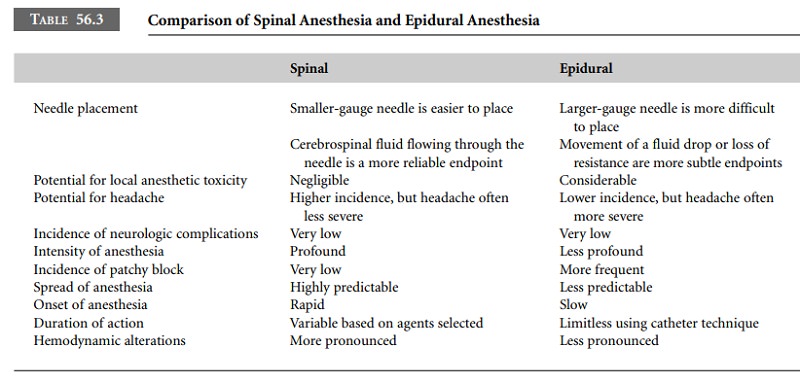Chapter: Clinical Cases in Anesthesia : Spinal Anesthesia
Explain the advantages of spinal anesthesia over epidural anesthesia
Explain the advantages of spinal anesthesia over epidural
anesthesia.
Although major similarities exist between
spinal anes-thesia and epidural anesthesia, significant differences are noted
(Table 56.3). Spinal anesthesia is usually accom-plished with a 26- or 22-gauge
needle, which is technically easier to manipulate between bony prominences than
the typical 17-gauge epidural needle. CSF flowing through the needle is a more
reliable indicator of proper needle place-ment than subtle movement of a liquid
drop or even loss of resistance as used in epidural techniques. Spinal
anesthesia requires minute amounts of local anesthetic which, if injected
intravascularly, often might not manifest central nervous system alterations.
Epidural techniques require such large amounts of local anesthetic that the
risk of toxicity from absorption is markedly increased. Direct intravascular
injection is almost certain to result in pro-found central nervous system and
cardiovascular collapse. Although spinal techniques are infamous for their
poten-tial to produce headaches, the intensity of the discomfort is often less
severe than that associated with unintentional dural puncture with the standard
17-gauge epidural needle. Epidural anesthesia offers a lower risk of headache
but frequently produces a more severe, incapacitating headache. The incidence
of significant neurologic compli-cations other than headache is extremely low
for both techniques. Spinal anesthesia tends to provide far more profound
analgesia than do epidural techniques. The inci-dence of patchy block is very
low with spinal anesthesia but considerably more frequent with epidural
anesthesia. Spread of anesthesia is more predictable with spinal tech-niques
using varying baricities and positions. Spread of anesthesia associated with
epidural techniques is less predictable and cannot be adjusted by position or
baricity of the injected anesthetic. The onset of spinal anesthesia is rapid
and that of epidural anesthesia tends to be slower. The duration of both
techniques is virtually limitless when using catheters. It is debatable whether
hemodynamic alterations and hypotension are more pronounced with spinal
anesthesia than with epidural anesthesia.

Related Topics